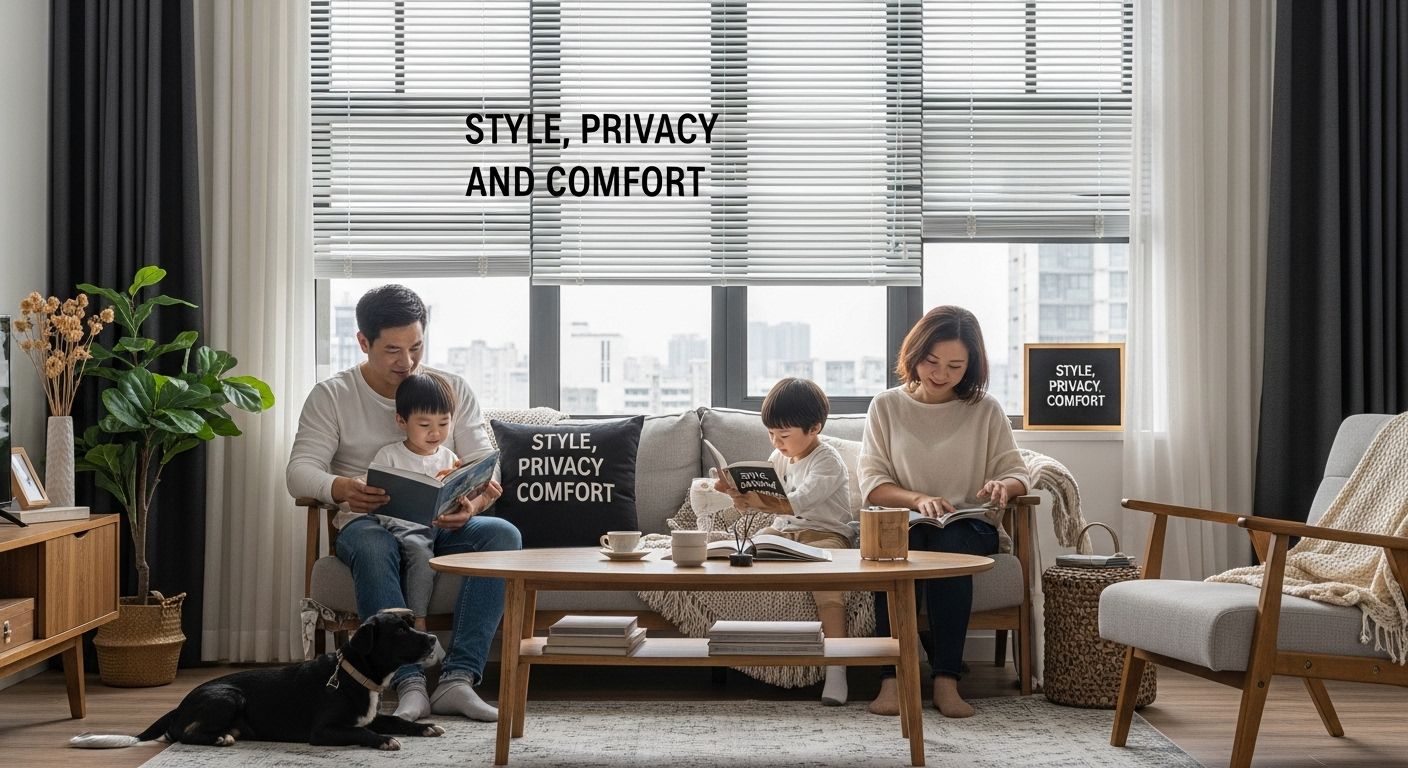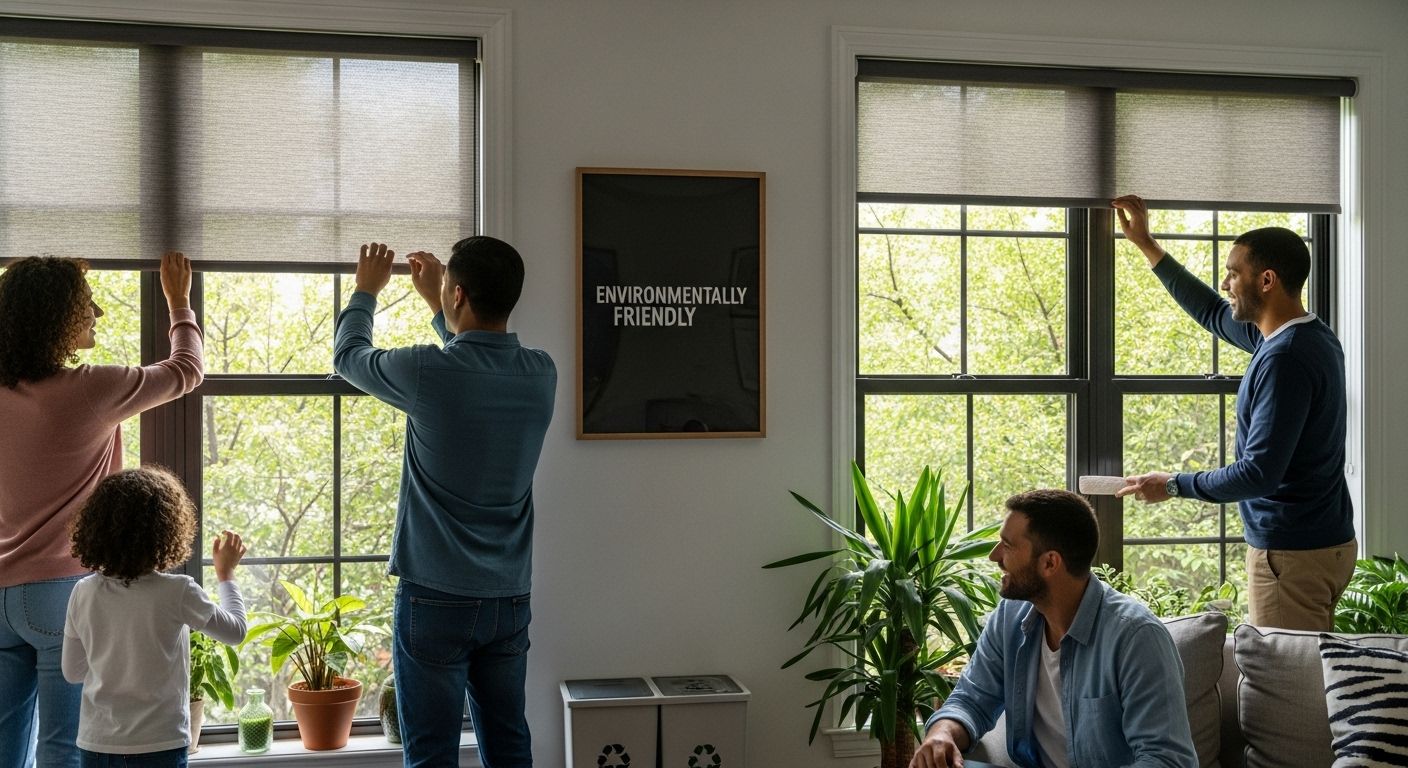
Understanding Environmentally Friendly Blinds: Benefits and Insights
Sustainable living is hitting home in a big way and it starts with the details we often overlook like our window blinds. Most people are surprised to find that environmentally friendly blinds can reduce energy consumption by up to 30 percent according to the Oak Ridge National Laboratory. So while stylish window coverings seem like a design choice, the real impact is found in how these blinds cut energy bills and help the planet at the same time.
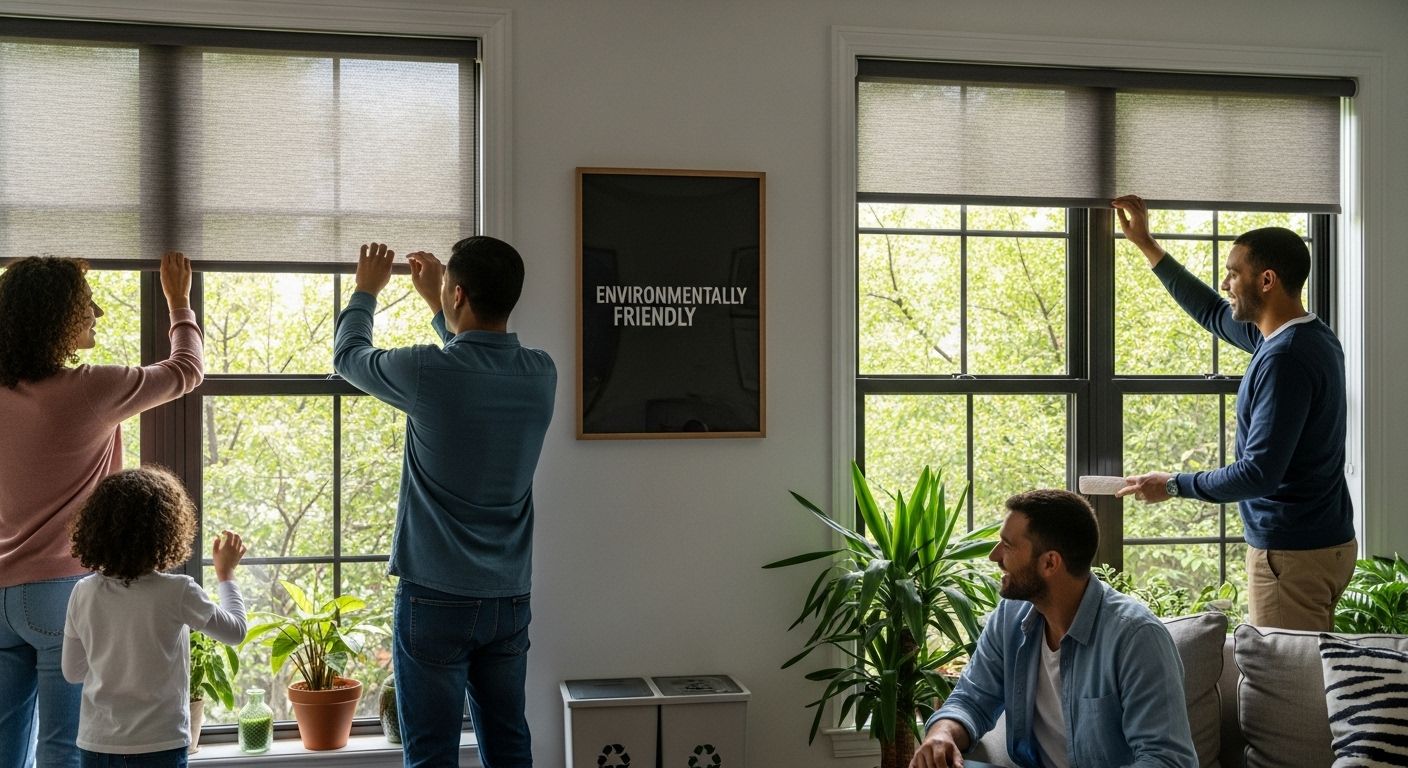
Table of Contents
- What Are Environmentally Friendly Blinds?
- Why Choose Environmentally Friendly Blinds?
- How Environmentally Friendly Blinds Work
- Key Materials and Features of Eco-Friendly Blinds
- The Impact of Environmentally Friendly Blinds on Interior Design
Quick Summary
| Takeaway | Explanation |
|---|---|
| Choose sustainable materials | Consider blinds made from bamboo, reclaimed wood, and recycled plastics for reduced environmental impact. |
| Enhance energy efficiency | Environmentally friendly blinds offer thermal insulation, reducing heating and cooling costs significantly. |
| Support global conservation | Selecting eco-friendly blinds helps minimize carbon emissions and promotes responsible manufacturing practices. |
| Enjoy long-term savings | These blinds can lower utility bills and may qualify for tax credits due to their energy-efficient features. |
| Elevate interior design | Eco-friendly blinds add aesthetic value and support a narrative of sustainability in home décor. |
What Are Environmentally Friendly Blinds?
Environmentally friendly blinds represent an innovative approach to window treatments that prioritize sustainability, energy efficiency, and reduced ecological impact. These specialized window coverings go beyond traditional designs by incorporating materials, manufacturing processes, and performance characteristics that minimize environmental strain while providing superior functionality.
Materials and Composition
Unlike conventional blinds, environmentally friendly blinds are crafted from sustainable, renewable, or recycled resources. This includes materials like:
- Bamboo, which grows rapidly and requires minimal agricultural intervention
- Reclaimed wood sourced from responsible forestry practices
- Recycled plastics transformed into durable window covering components
- Organic textiles like hemp or cotton produced through low-impact cultivation methods
According to Oak Ridge National Laboratory, these specialized window treatments can provide substantial energy savings, particularly cellular or honeycomb-structured designs that offer superior thermal insulation.
Energy Performance and Design
Environmentally friendly blinds distinguish themselves through advanced energy management capabilities. The U.S. Department of Energy highlights that strategic window coverings can significantly reduce heat transfer, helping homeowners maintain comfortable indoor temperatures while minimizing heating and cooling expenses.
Key energy performance features include:
- Cellular shade structures that trap air and provide natural insulation
- Reflective materials that redirect solar radiation
- Designs enabling precise light and temperature control
By selecting environmentally friendly blinds, consumers make a conscious choice to reduce their carbon footprint while enhancing home comfort and aesthetic appeal. These window treatments represent more than just decorative elements they are active contributors to sustainable living practices. Want to explore more about green window solutions? Check out our comprehensive guide on sustainable window treatments.
Why Choose Environmentally Friendly Blinds?
Environmentally friendly blinds represent more than a trendy home decor choice they are a strategic investment in sustainable living, personal comfort, and long term environmental responsibility. Homeowners increasingly recognize that window treatments can significantly impact both household energy consumption and ecological footprint.
Economic and Environmental Benefits
Choosing environmentally friendly blinds delivers substantial advantages that extend beyond aesthetic appeal. Financial savings emerge through improved energy efficiency, with these specialized window coverings reducing heating and cooling expenses. According to Oak Ridge National Laboratory, cellular and honeycomb structured blinds can dramatically decrease energy consumption by minimizing heat transfer.
Key economic advantages include:
- Reduced monthly utility bills through superior thermal insulation
- Potential tax credits for energy efficient home improvements
- Extended lifespan compared to traditional window treatments
- Lower replacement costs due to durable, sustainable materials
The following table presents the major economic and environmental benefits of choosing environmentally friendly blinds, summarizing how these window treatments provide value both personally and globally.
| Benefit Type | Specific Advantage |
|---|---|
| Economic | Reduces monthly utility bills |
| Economic | Potential qualification for tax credits |
| Economic | Extended lifespan over traditional window treatments |
| Economic | Fewer replacements due to durable materials |
| Environmental | Minimizes carbon emissions |
| Environmental | Supports responsible manufacturing |
| Environmental | Decreases use of non-renewable resources |
| Environmental | Promotes circular economy principles |
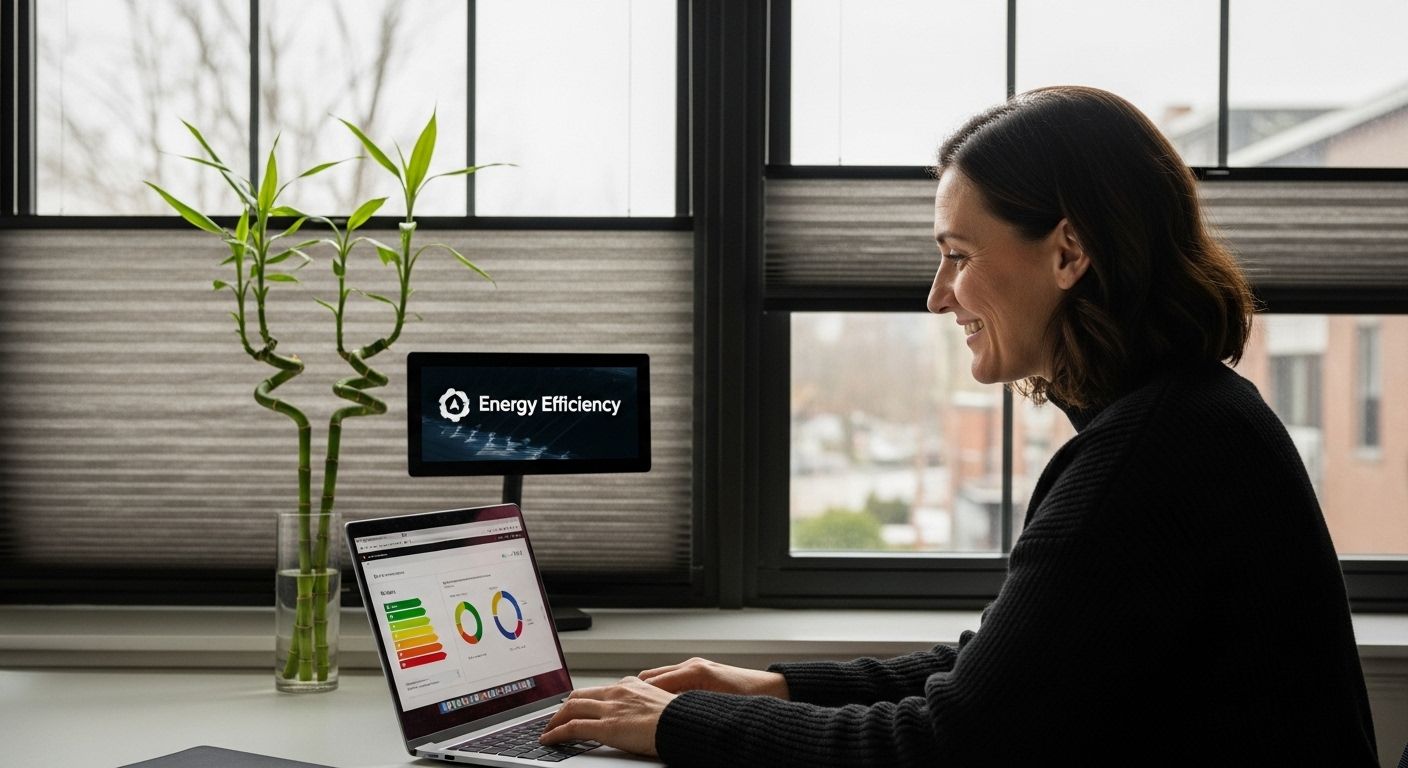
Personal and Global Impact
Beyond immediate financial benefits, environmentally friendly blinds contribute to broader ecological preservation efforts. By selecting products manufactured with sustainable practices and renewable materials, consumers directly support global environmental conservation.
Environmental contributions encompass:
- Minimizing carbon emissions through reduced energy consumption
- Supporting responsible manufacturing practices
- Decreasing demand for non renewable resources
- Promoting circular economy principles
Want to learn more about making your home more sustainable? Discover our comprehensive green window treatment solutions that can transform your living space while protecting our planet.
How Environmentally Friendly Blinds Work
Environmentally friendly blinds operate through sophisticated design principles that optimize energy efficiency, light management, and thermal regulation. These innovative window treatments leverage advanced materials and engineering to create intelligent solutions that adapt to changing environmental conditions.
Thermal Insulation Mechanisms
Cellular structure is the cornerstone of energy efficient blind performance. According to Oak Ridge National Laboratory, these specialized designs create air pockets that act as thermal barriers, significantly reducing heat transfer between indoor and outdoor environments.
Key thermal insulation features include:
- Honeycomb shaped chambers that trap air
- Multiple layered materials with different thermal properties
- Reflective inner surfaces that redirect solar radiation
- Precision engineered fabric densities that minimize heat conductivity
Light and Solar Management
Environmentally friendly blinds excel at intelligent light control, dynamically managing solar exposure to maintain optimal indoor comfort. These window treatments use specialized materials and configurations to:
- Reduce direct sunlight penetration
- Minimize UV radiation entering living spaces
- Distribute natural light evenly without creating glare
- Maintain visual transparency while blocking heat
Smart Integration and Performance
Modern environmentally friendly blinds incorporate advanced technologies that enhance their functionality. Explore our cutting edge motorized blind solutions that enable automated light and temperature management. These intelligent systems can:
- Adjust automatically based on sunlight intensity
- Integrate with home automation systems
- Provide real time energy performance data
- Optimize indoor climate conditions with minimal user intervention
By combining sophisticated material science, thermal engineering, and smart technologies, environmentally friendly blinds transform window treatments from passive decorative elements into active energy management systems.
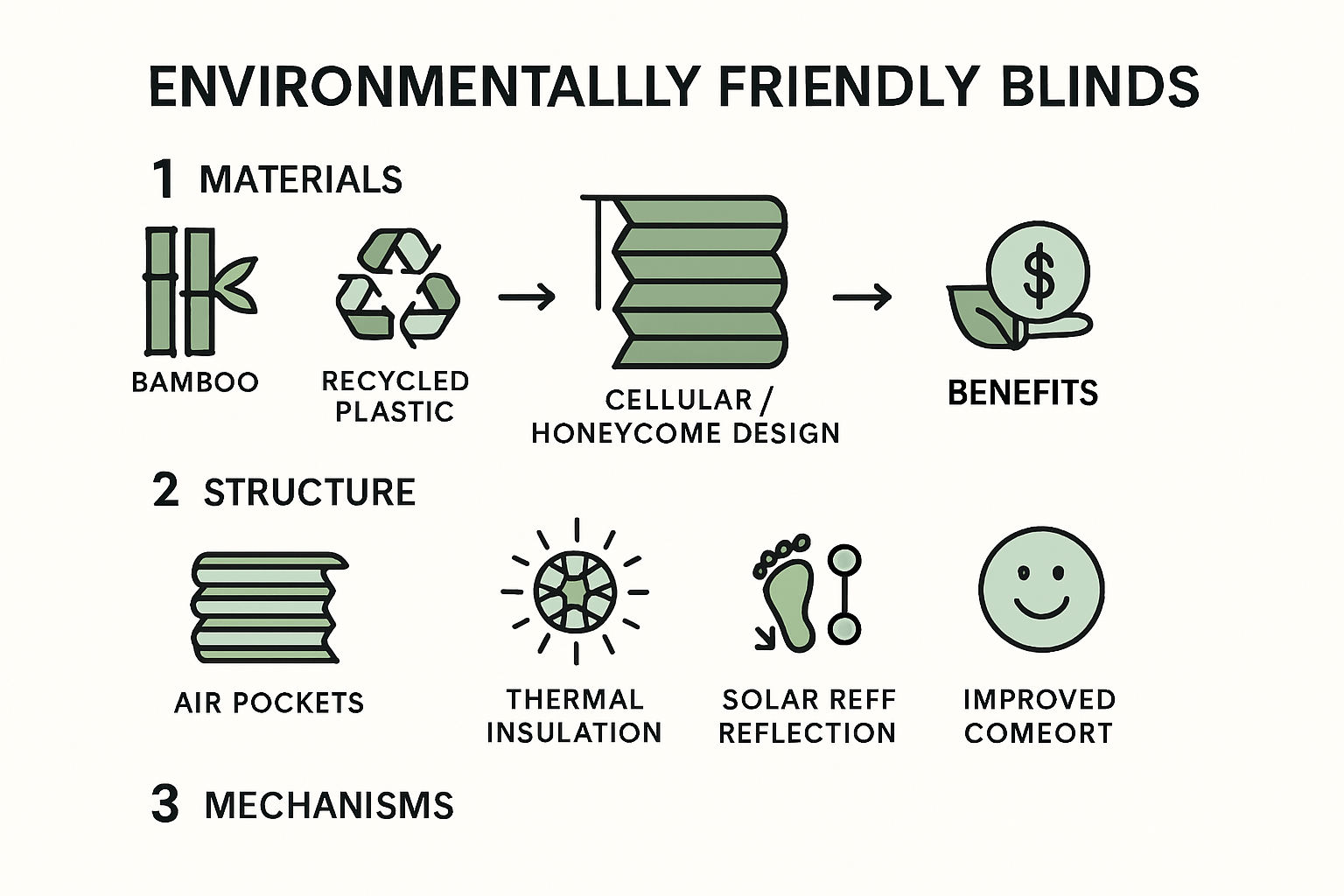
Key Materials and Features of Eco-Friendly Blinds
Eco-friendly blinds represent a sophisticated fusion of sustainable materials, advanced engineering, and environmental consciousness. These window treatments transcend traditional design by incorporating innovative components that minimize ecological impact while maximizing performance and aesthetic appeal.
Sustainable Material Composition
Renewable and recycled materials form the foundation of environmentally responsible blinds. According to the U.S. Department of Energy, selecting materials with low environmental footprints is crucial for creating truly sustainable window treatments.
Key sustainable material options include:
- Bamboo sourced from responsibly managed forests
- Recycled aluminum and plastics
- Organic cotton and hemp fabrics
- Reclaimed wood from sustainable forestry practices
- Natural fibers processed using low impact techniques
To better understand the variety of sustainable materials used in environmentally friendly blinds, the table below organizes the main options along with their sources and key environmental benefits.
| Material | Source | Key Environmental Benefit |
|---|---|---|
| Bamboo | Responsibly managed forests | Rapid renewability, minimal pesticide use |
| Reclaimed Wood | Sustainable forestry, salvage | Reduces deforestation, repurposes materials |
| Recycled Plastics | Consumer or industrial recycled plastics | Diverts waste, lowers virgin material use |
| Organic Cotton | Low-impact cotton cultivation | Fewer chemicals, sustainable agriculture |
| Hemp | Low-impact hemp farming | Rapid growth, low water and pesticide needs |
| Recycled Aluminum | Post-consumer recycled metals | Less energy used than new aluminum production |
| Natural Fibers | Eco-conscious, low-impact processing | Biodegradable, reduced chemical input |
Performance and Environmental Characteristics
Beyond material selection, eco-friendly blinds distinguish themselves through superior functional attributes. These window treatments are engineered to deliver exceptional energy efficiency and environmental performance.
Critical performance features encompass:
- Low volatile organic compound (VOC) emissions
- Superior thermal insulation capabilities
- UV radiation blocking properties
- Durability that reduces replacement frequency
- Minimal manufacturing waste generation
Smart Design and Technological Integration
Modern eco-friendly blinds integrate cutting edge technologies that enhance their environmental credentials. Explore our innovative green window treatment solutions that represent the pinnacle of sustainable design. These advanced window coverings leverage smart technologies to optimize energy consumption, providing homeowners with both ecological responsibility and technological convenience.
By meticulously selecting materials, prioritizing performance, and embracing innovative design principles, eco-friendly blinds represent a holistic approach to sustainable home design that does not compromise on functionality or aesthetic appeal.
The Impact of Environmentally Friendly Blinds on Interior Design
Environmentally friendly blinds have transformed from mere functional window coverings to sophisticated design elements that communicate a homeowner’s commitment to sustainability, aesthetic innovation, and ecological responsibility. These sophisticated window treatments seamlessly integrate environmental consciousness with contemporary interior design principles.
Aesthetic Versatility and Design Language
Sustainable design is no longer a niche concept but a mainstream design philosophy. According to research in interior design sustainability, eco-friendly materials can significantly enhance the visual and experiential quality of interior spaces.
Key aesthetic contributions include:
- Natural textures that add organic warmth to contemporary spaces
- Neutral color palettes that complement minimalist design trends
- Subtle visual narratives that communicate environmental awareness
- Diverse material options representing ecological diversity
- Textures that reflect responsible manufacturing processes
Environmental Storytelling Through Design
Environmentally friendly blinds serve as visual statements of ecological commitment. They transform windows from passive architectural elements into active representations of sustainable living. These window treatments communicate a narrative of environmental responsibility through:
- Material transparency and origin stories
- Visible commitment to reduced carbon footprint
- Integration of innovative, low impact manufacturing techniques
- Celebration of natural material aesthetics
- Demonstration of design innovation through sustainable practices
Functional Elegance and Space Transformation
Modern interior design increasingly recognizes that sustainability and aesthetics are not mutually exclusive. Discover how green window treatments can elevate your home design, transforming spaces into intelligent, responsive environments that balance beauty, functionality, and environmental consciousness.
By thoughtfully selecting environmentally friendly blinds, homeowners create spaces that are not just visually compelling but also narratively rich, reflecting a holistic approach to design that honors both aesthetic excellence and ecological responsibility.
Ready to Experience the Benefits of Eco-Friendly Blinds in Your Home?
Choosing environmentally friendly blinds goes beyond saving energy. Your goal is to make your home more comfortable, beautiful, and sustainable while reducing your carbon footprint. You deserve window treatments that combine style, insulation, and planet-friendly materials. The challenge is finding custom blinds that truly meet these high standards. At Value Blinds, we offer a curated selection of features and styles designed for homeowners who want it all—eco-conscious materials, advanced energy efficiency, and tailor-made designs. Discover trending sustainable options, like cellular shades and bamboo blinds, in our Trending Features collection.
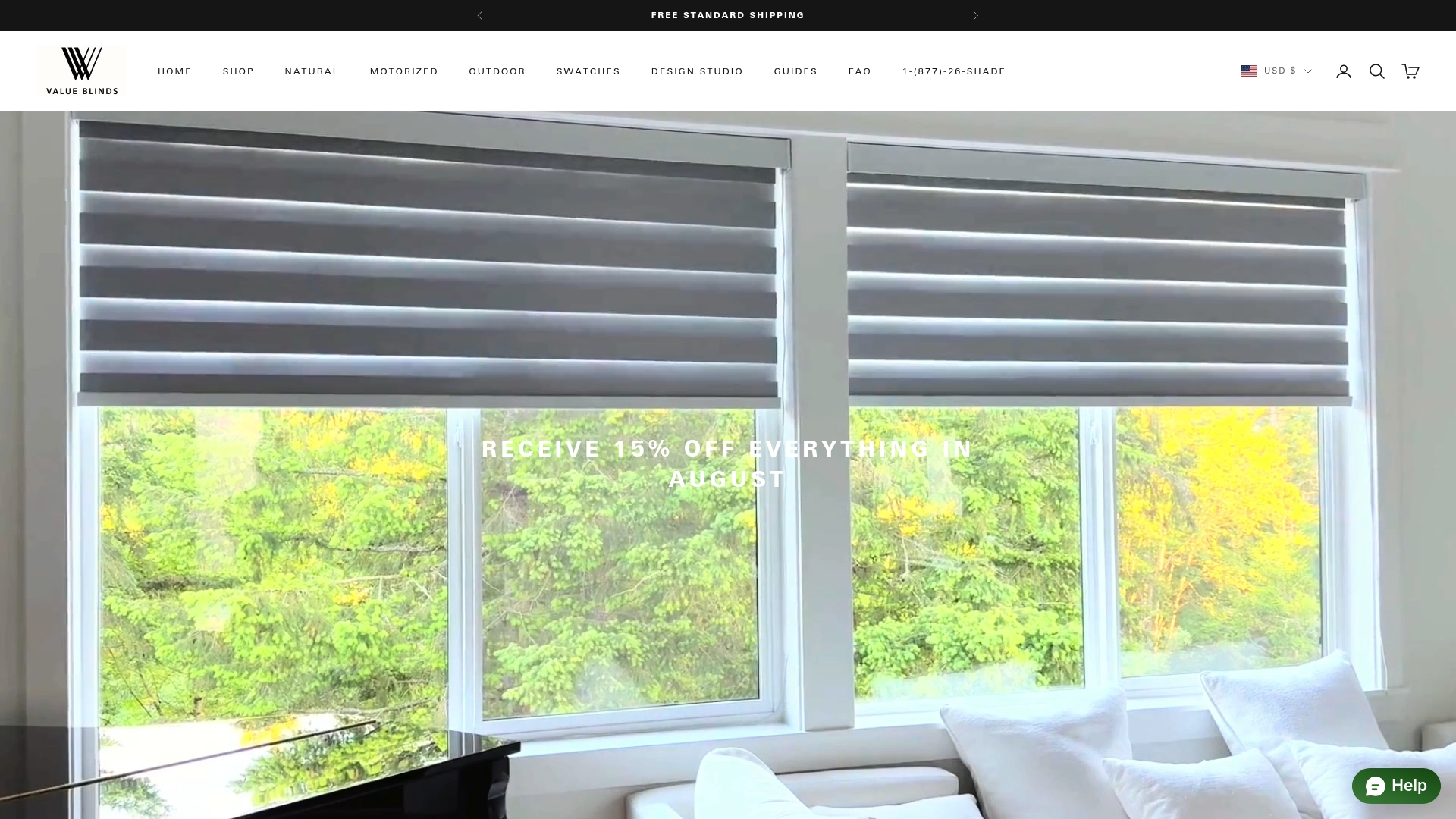
Feel the difference sustainable design can make. Shop now at Value Blinds and use our measurement guides, free swatches, and expert support to create your personalized solution. Give your home a green upgrade today—because you should never have to choose between beauty, comfort, and sustainability.
Frequently Asked Questions
What are environmentally friendly blinds?
Environmentally friendly blinds are window treatments designed with sustainable materials and energy-efficient properties to minimize ecological impact while optimizing interior comfort.
What materials are used in eco-friendly blinds?
Eco-friendly blinds are typically made from sustainable resources such as bamboo, reclaimed wood, recycled plastics, and organic textiles like hemp or cotton, promoting responsible manufacturing practices.
How do environmentally friendly blinds improve energy efficiency?
These blinds feature advanced designs, such as cellular structures that trap air for thermal insulation, reflective materials that redirect solar radiation, and configurations that enable precise light and temperature control, thereby reducing heating and cooling costs.
Can eco-friendly blinds enhance my home’s interior design?
Yes, environmentally friendly blinds can add aesthetic value with natural textures, a neutral color palette, and innovative designs that align with modern interior decor trends while also contributing to an eco-conscious living space.
Recommended
- Sustainable and Eco-Friendly Blinds: Discover Green Window Treatments
- Motorized Blinds: Enhance Your Home with Convenience and Style
- Blinds vs. Shades: Which Window Treatment Is Best for Your Home?
- What Are Honeycomb Blinds? All You Need to Know
- The Benefits of Using Eco-Friendly Plumbing Products - Delta Plumbers | Ottawa
- Choosing Eco-Friendly Carpet Cleaners in 2025: A Guide for Yarra Valley Residents - Yarra Valley Carpet Cleaning


